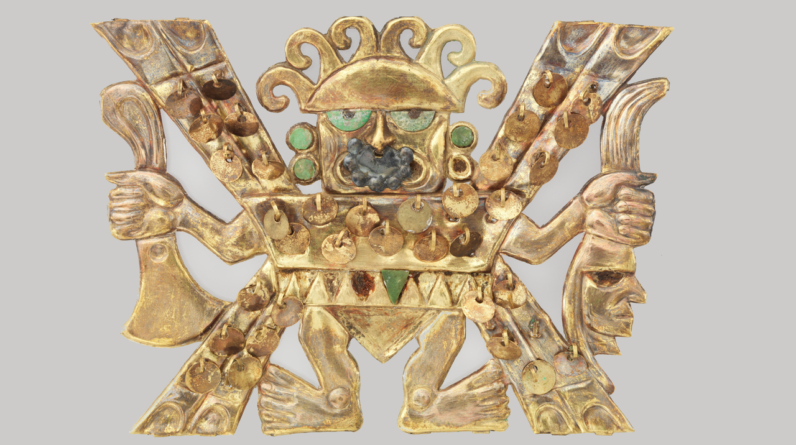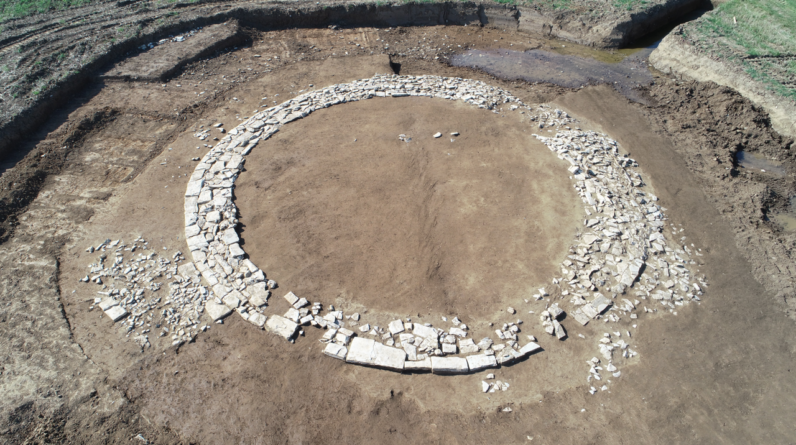
(Image credit: Ina Meer Sommer via Shutterstock)
The remains of a garment from an ancient tomb in Greece may be a tunic that was once worn by Alexander the Great, a scholar claims in a new study.
The garment was found in a tomb that many scholars believe belonged to Alexander’s father, Philip II. It’s next to two other tombs thought to hold other royal members of Alexander’s family.
The new study, however, claims that this particular tomb doesn’t belong to Alexander’s father, but to Alexander’s half-brother, Philip III (also known as Arrhidaeus). The study also claims that the cotton cloth found in the tomb was once part of a tunic worn by Alexander that, after his death, was passed to Arrhideus and buried with him in this tomb.
The tunic was sacred because only Alexander the Great was allowed to wear it, said Antonis Bartsiokas, professor emeritus of physical anthropology and paleoanthropology at the Democritus University of Thrace and author of the study, published Oct. 17 in the Journal of Field Archaeology. By the time of Alexander’s death, some people considered him a god, Bartsiokas told Live Science in an email.
However, not all of the scholars Live Science spoke with supported the findings, with one scholar saying that it is not a tunic at all.
Related: Did Alexander the Great have any children?
A king’s tomb
The garment was found in 1977 in a gold chest in a tomb near the town of Vergina (formerly the capital of Macedonia) in what is now Greece. The tomb has two skeletons that are, according to Bartsiokas, those of Arrhidaeus and his wife Eurydice.
After Alexander died in 323 B.C., Arrhidaeus became king of Alexander’s empire. Historical records indicate that Arrhidaeus lived with some form of mental disability and was unable to rule. Alexander’s officials and generals fought for power, and the empire disintegrated with the killing of Arrhidaeus in 317 B.C.
Bartsiokas contends that after Alexander died, this tunic was given to Arrhidaeus and, after Arrhidaeus was killed, was buried with him. In his paper, Bartsiokas cites evidence for this idea, such as the art on the tomb’s walls, studies of the skeletons found in the tomb, and an analysis of ancient historical records. Bartsiokas also looked at past tests done on the garment, including energy dispersive X-ray spectroscopy, a technique that analyzes X-rays to determine what an object is made of, and fourier-transform infrared spectroscopy, which uses infrared light to analyze objects.
Alexander’s tunic?
Bartsiokas contends that tests done by other scholars show that the garment was a sarapis, or a tunic. The tunic is made of three layers. Two of the layers are made of cotton that has been dyed purple. Between the two layers of cotton there is a flexible layer of a mineral called huntite. Purple was worn by kings in the ancient world, he noted, and cotton was grown in Persia, but not in Greece, during Alexander’s time. Ancient historical records indicate that “cotton was introduced to Greece and Europe by Alexander’s army following the conquest of the Persian Empire,” Bartsiokas wrote in his paper.
Bartsiokas also cited ancient records claiming that the king of Persia wore a tunic that used cotton and huntite and that Alexander wore a tunic like this after he conquered Persia. He noted that Philip II was not a ruler of Persia and would not have worn a tunic that used cotton or huntite.
In addition, the artwork on the wall of the tomb — an illustrated group of hunters — depicts Alexander wearing a tunic similar to the one found, Bartsiokas said, and the artwork’s details suggest the artist was familiar with Persia’s landscape and wildlife.
Related: Where is Alexander the Great’s tomb?
Additionally, the painting is done in a complicated style that would have taken a long time to complete, meaning the burial likely didn’t belong to Philip II. That’s because Philip II was assassinated in 336 B.C. and Alexander went on a military campaign shortly afterward, which means the artist would not have had time to create it before Philip II’s funeral, Bartsiokas explained.
Another reason the garment didn’t belong to Philip II, Bartsiokas said, is that the king suffered a wound to his right eye, but neither skeleton in the tomb has an indication of such a wound.
Controversy
The scholars Live Science spoke with had mixed reactions to Bartsiokas’ paper.
Hariclia Brecoulaki, a senior researcher at the National Hellenic Research Foundation’s Institute of Historical Research in Greece, said there is no evidence to support the idea that this garment was a tunic. “The textile, according to the excavators, looked more like a piece of scarf that served to wrap the bones of the deceased,” Brecoulaki told Live Science in an email.
Athanasia Kyriakou, director of the Aristotle University of Thessaloniki’s excavation project at Vergina, also criticized the paper. “This article is full with faulty understandings due to a lack of the relevant background,” Kyriakou said in an email. Bartsiokas did not conduct tests on the materials himself, Kyriakou noted, adding that Bartsiokas “has not even seen the materials.”
Other scholars were more supportive of the paper and its findings. “I am sympathetic to Antonis Bartsiokas’s arguments that it belongs to Philip III,” Susan Rotroff, a professor emerita of classics at Washington University in St. Louis, said in an email. “If the textile in question really is cotton, it is hard to support a date before the time of Alexander the Great.”
Richard Janko, a classical studies professor at the University of Michigan, was cautiously supportive. “This is a very exciting piece of research,” Janko told Live Science in an email. “The original identification of the male occupant of the extraordinarily rich Tomb II at Vergina as Philip II, the father of Alexander, is far from secure.”
However, Janko noted that the cotton used to make the garment could have been imported through trade from Persia, which means that it could have been acquired and used by Philip II.
David Gill, a fellow at the University of Kent’s Centre for Heritage, commended the paper’s findings. “Some years ago I published the weight inscriptions from Tomb II — and I argued that they had to post-date Philip II,” Gill told Live Science in an email. Several objects in the tomb, such as silver plates, have their weights inscribed on them.
He found the paper’s arguments that the garment was a tunic used by Alexander the Great to be strong. “It is likely that this was an item that was worn by Alexander the Great,” Gill said.
As an Amazon Associate I earn from qualifying purchases.







